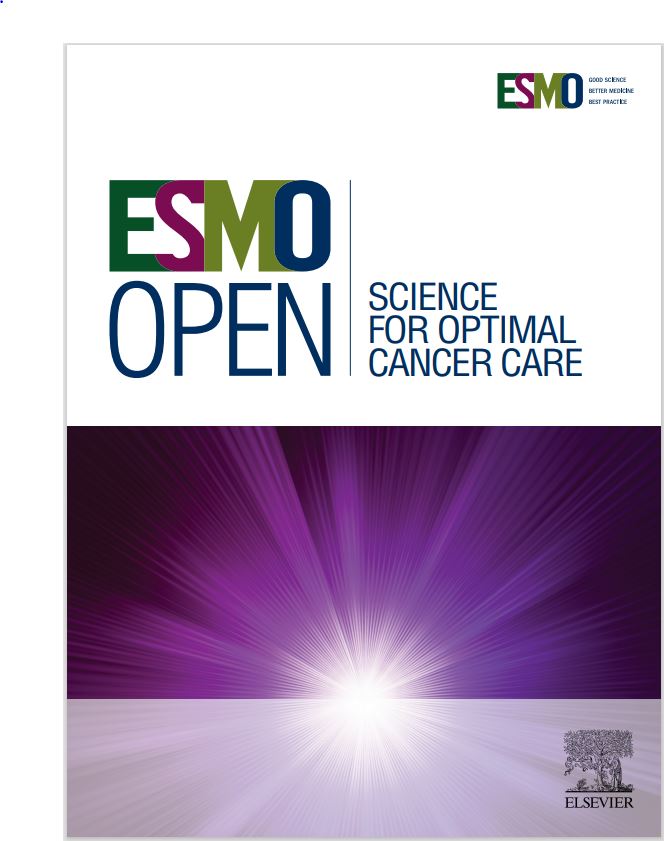pembrolizumab单用和联合化疗治疗PD-L1表达≥50%的转移性肺腺癌患者的现实世界比较
IF 7.1
2区 医学
Q1 ONCOLOGY
引用次数: 0
摘要
目的高程序性死亡配体1 (PD-L1)表达(≥50%)的转移性肺腺癌的一线治疗包括免疫检查点抑制剂(ICIs)单药或联合化疗。在这种情况下,化疗的额外益处在头对头试验中缺乏直接比较。我们的目的是在现实世界中比较这两种ICI治疗方式的总体和相关患者亚组。材料和方法这项回顾性的全国性研究纳入了2017年至2021年在挪威诊断为IV期非小细胞肺腺癌的410例患者,PD-L1表达≥50%,并使用ICI派姆单抗进行一线治疗,单药治疗(n = 317)或联合铂类化疗(n = 93)。我们使用Cox回归分析治疗开始后的早期(6个月)和总体(3年)死亡风险,并根据性别、年龄、分期、PD-L1表达、表现状态和教育程度进行调整和分层。结果联合治疗患者的中位总生存期高于单药治疗患者(22.6个月vs 14.2个月),总死亡风险降低,但调整后无统计学意义[风险比(HR) 0.74, 95%可信区间(CI) 0.54-1.00]。然而,即使在调整后,接受联合治疗的患者早期死亡风险也显著降低(HR 0.41, 95% CI 0.23-0.76)。在大多数亚组中,与接受单一治疗的患者相比,接受联合治疗的患者具有相当或更好的生存结果。特别值得注意的是,在女性、IVB期疾病患者和PD-L1表达超过75%的患者中,联合治疗优于单药治疗。结论:我们的现实世界研究表明,在pd - l1高患者中,ICI和化疗联合治疗比单药治疗提供了更好的早期生存益处。此外,某些亚组的总生存率有所提高。这些发现对当前的治疗实践提出了挑战,并强调需要进一步验证以优化单药治疗与联合治疗的患者选择,特别是重新评估PD-L1在治疗决策中的作用。本文章由计算机程序翻译,如有差异,请以英文原文为准。
Real-world comparison of pembrolizumab alone and combined with chemotherapy in metastatic lung adenocarcinoma patients with PD-L1 expression ≥50%
Objectives
The frontline treatment of metastatic lung adenocarcinoma with high Programmed death-ligand 1 (PD-L1) expression (≥50%) includes immune checkpoint inhibitors (ICIs) either as monotherapy or combined with chemotherapy. The added benefit of chemotherapy in this context lacks direct comparison in head-to-head trials. We aimed to compare these two ICI treatment modalities both overall and within relevant patient subgroups in a real-world setting.
Materials and methods
This retrospective, nationwide study included 410 individuals diagnosed in Norway during 2017 to 2021 with stage IV non-small-cell lung adenocarcinoma, PD-L1 expression ≥50%, and treated first line with the ICI pembrolizumab, either as monotherapy (n = 317) or in combination with platinum-based chemotherapy (n = 93). We analyzed early (6-month) and overall (3-year) risk of death after treatment initiation using Cox regression, adjusted for and stratified by sex, age, stage, PD-L1 expression, performance status, and education.
Results
Patients treated with combination therapy had a higher median overall survival compared with monotherapy (22.6 months versus 14.2 months), and reduced risk of overall death, although not statistically significant after adjustment [hazard ratio (HR) 0.74, 95% confidence interval (CI) 0.54-1.00]. However, the risk of early death was significantly lower in patients receiving combination therapy, even after adjustment (HR 0.41, 95% CI 0.23-0.76). Across most subgroups, patients receiving combination therapy had comparable or superior survival outcomes relative to those receiving monotherapy. Particularly noteworthy were the observed benefits from combination therapy over monotherapy among females, individuals with stage IVB disease, and those with PD-L1 expression exceeding 75%.
Conclusion
Our real-world study demonstrates that combination therapy with ICI and chemotherapy provides superior early survival benefits over monotherapy in PD-L1-high patients. Additionally, certain subgroups showed enhanced overall survival. These findings challenge current treatment practices and underscore the need for further validation to optimize patient selection for monotherapy versus combination therapy, in particular to reassess the role of PD-L1 in treatment decisions.
求助全文
通过发布文献求助,成功后即可免费获取论文全文。
去求助
来源期刊

ESMO Open
Medicine-Oncology
CiteScore
11.70
自引率
2.70%
发文量
255
审稿时长
10 weeks
期刊介绍:
ESMO Open is the online-only, open access journal of the European Society for Medical Oncology (ESMO). It is a peer-reviewed publication dedicated to sharing high-quality medical research and educational materials from various fields of oncology. The journal specifically focuses on showcasing innovative clinical and translational cancer research.
ESMO Open aims to publish a wide range of research articles covering all aspects of oncology, including experimental studies, translational research, diagnostic advancements, and therapeutic approaches. The content of the journal includes original research articles, insightful reviews, thought-provoking editorials, and correspondence. Moreover, the journal warmly welcomes the submission of phase I trials and meta-analyses. It also showcases reviews from significant ESMO conferences and meetings, as well as publishes important position statements on behalf of ESMO.
Overall, ESMO Open offers a platform for scientists, clinicians, and researchers in the field of oncology to share their valuable insights and contribute to advancing the understanding and treatment of cancer. The journal serves as a source of up-to-date information and fosters collaboration within the oncology community.
 求助内容:
求助内容: 应助结果提醒方式:
应助结果提醒方式:


